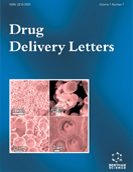Abstract
Background and Objective: The 4T1 murine breast cancer cell line is commonly employed to study breast cancer metastasis. Transfections to this cell line are frequently carried out using lipid/polymer based gene delivery vehicles. The research paper attempts to use peptide based transfecting agents Str-R8 and MTS-AR8 for in vitro transfection of 4T1 cells.
Methods: These peptides were investigated previously by the authors and showed comparable plasmid DNA complexation abilities. The efficiency of Str-R8, MTS-AR8 in delivery of the plasmid DNA, pSFCMV- SEAP to 4T1 cells is compared to the cationic lipid reagent Lipofectamine®3000. Transfection was measured by estimating the ability of the expressed reporter gene i.e., secreted alkaline phophatase to cleave the substrate para-Nitrophenylphosphate to para-Nitrophenol. Results: Transfection of 4T1 by MTS-AR8/pSF-CMV-SEAP was twofold greater than that mediated by Str-R8/pSF-CMV-SEAP (probability of the values being similar; p<0.05) and comparable to Lipofectamine ®3000/pSF-CMV-SEAP (probability of the values being similar; p>0.5) at a peptide basic amino acid per nucleic acid phosphate ratio of 5:1. Increasing the peptide basic amino acid per nucleic acid phosphate ratio, of MTS-AR8 resulted in a decrease in the transfection of 4T1 cells (probability of the obtained values being similar; p <0.06). Conclusion: The MTS-AR8 peptide has potential and can be further investigated for nucleic acid delivery involving the 4T1 cell line.Keywords: 4T1, MTS-AR8, Str-R8, Lipofectamine, pSF-CMV-SEAP, Transfection.
Graphical Abstract
Drug Delivery Letters
Title:A Cell Penetrating Peptide, MTS-AR8, for Transfection of 4T1 Murine Breast Cancer Cells
Volume: 7 Issue: 1
Author(s): Archana Upadhya and Preeti C. Sangave
Affiliation:
Keywords: 4T1, MTS-AR8, Str-R8, Lipofectamine, pSF-CMV-SEAP, Transfection.
Abstract: Background and Objective: The 4T1 murine breast cancer cell line is commonly employed to study breast cancer metastasis. Transfections to this cell line are frequently carried out using lipid/polymer based gene delivery vehicles. The research paper attempts to use peptide based transfecting agents Str-R8 and MTS-AR8 for in vitro transfection of 4T1 cells.
Methods: These peptides were investigated previously by the authors and showed comparable plasmid DNA complexation abilities. The efficiency of Str-R8, MTS-AR8 in delivery of the plasmid DNA, pSFCMV- SEAP to 4T1 cells is compared to the cationic lipid reagent Lipofectamine®3000. Transfection was measured by estimating the ability of the expressed reporter gene i.e., secreted alkaline phophatase to cleave the substrate para-Nitrophenylphosphate to para-Nitrophenol. Results: Transfection of 4T1 by MTS-AR8/pSF-CMV-SEAP was twofold greater than that mediated by Str-R8/pSF-CMV-SEAP (probability of the values being similar; p<0.05) and comparable to Lipofectamine ®3000/pSF-CMV-SEAP (probability of the values being similar; p>0.5) at a peptide basic amino acid per nucleic acid phosphate ratio of 5:1. Increasing the peptide basic amino acid per nucleic acid phosphate ratio, of MTS-AR8 resulted in a decrease in the transfection of 4T1 cells (probability of the obtained values being similar; p <0.06). Conclusion: The MTS-AR8 peptide has potential and can be further investigated for nucleic acid delivery involving the 4T1 cell line.Export Options
About this article
Cite this article as:
Upadhya Archana and Sangave C. Preeti , A Cell Penetrating Peptide, MTS-AR8, for Transfection of 4T1 Murine Breast Cancer Cells, Drug Delivery Letters 2017; 7 (1) . https://dx.doi.org/10.2174/2210303107666170213101703
| DOI https://dx.doi.org/10.2174/2210303107666170213101703 |
Print ISSN 2210-3031 |
| Publisher Name Bentham Science Publisher |
Online ISSN 2210-304X |
 12
12 1
1 2
2
- Author Guidelines
- Bentham Author Support Services (BASS)
- Graphical Abstracts
- Fabricating and Stating False Information
- Research Misconduct
- Post Publication Discussions and Corrections
- Publishing Ethics and Rectitude
- Increase Visibility of Your Article
- Archiving Policies
- Peer Review Workflow
- Order Your Article Before Print
- Promote Your Article
- Manuscript Transfer Facility
- Editorial Policies
- Allegations from Whistleblowers
Related Articles
-
Patent Selections
Recent Patents on Anti-Cancer Drug Discovery Anticancer Properties of Asian Water Monitor Lizard (Varanus salvator), Python (Malayopython reticulatus) and Tortoise (Cuora kamaroma amboinensis)
Anti-Cancer Agents in Medicinal Chemistry Vascular Endothelial Growth Factor as an Anti-Angiogenic Target for Cancer Therapy
Current Drug Targets Cancer Molecular Imaging: Radionuclide-Based Biomarkers of the Epidermal Growth Factor Receptor (EGFR)
Current Topics in Medicinal Chemistry 2(3)-Aryl-thio(oxy)-methylquinoxaline Derivatives: A New Class of P-Glycoprotein-Mediated Drug Efflux Inhibitors
Medicinal Chemistry Neuropeptide Y Induces Cardiomyocyte Hypertrophy <i>via</i> Attenuating miR-29a-3p in Neonatal Rat Cardiomyocytes
Protein & Peptide Letters Phytochemicals and Cancer Stem Cells: A Pancreatic Cancer Overview
Current Chemical Biology Micropropagation: A Tool for the Production of High Quality Plant-based Medicines
Current Pharmaceutical Biotechnology Development of Environment-Friendly Insecticides Based on Enantioselectivity: Bifenthrin as a Case
Current Protein & Peptide Science β-Galactosidase and Galactooligosaccharides Production and Applications
Recent Patents on Chemical Engineering Meet Our Editorial Board Member:
Central Nervous System Agents in Medicinal Chemistry Tc-99m Radiolabeled Alendronate Sodium Microemulsion: Characterization and Permeability Studies Across Caco-2 Cells
Current Drug Delivery A Review of the Current Role of Proton Therapy in Modern Oncology
Current Drug Therapy Thermal Imaging Techniques for Breast Screening - A Survey
Current Medical Imaging Differentiation Potential of Human Retinoblastoma Cells
Current Pharmaceutical Biotechnology Biomarkers of Osteoarthritis: A Review of Recent Research Progress on Soluble Biochemical Markers, Published Patents and Areas for Future Development
Recent Patents on Biomarkers AMPK: Therapeutic Target for Diabetes and Cancer Prevention
Current Pharmaceutical Design Rational Drug Design of Antineoplastic Agents Using 3D-QSAR, Cheminformatic, and Virtual Screening Approaches
Current Medicinal Chemistry Cinnamic Acid Derivatives as Anticancer Agents-A Review
Current Medicinal Chemistry Targeting Negative Regulators of TRIF-dependent TLR Signaling Pathway as a Novel Therapeutic Strategy
Current Signal Transduction Therapy


























